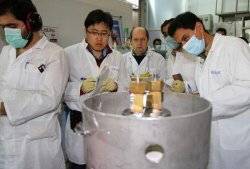Iran offers more nuclear sites for inspection
10/02/2014| IslamWeb
Iran has agreed to an inspection of the Saghand uranium mine, as part of a seven-step plan with the International Atomic Energy Agency (IAEA) to ease international fears about its nuclear programme.
The IAEA also announced on Sunday that Tehran was ready to "provide information and explanations" for experiments in a type of detonator that the agency said could be used to trigger a nuclear explosion, according to Associated Press news agency.
The agency said in a statement that there had been "constructive technical meetings" within a framework that was agreed last November, according to Reuters news agency.
"During the meetings, the two sides reviewed progress on the implementation of the six initial practical measures that were agreed three months ago. Iran has taken the initial practical measures that were foreseen, the agency said in a statement.
"Iran and the agency reached agreement on seven practical measures to be implemented by Iran by 15 May 2014."
Sunday's announcement would be a potentially significant step forward, as the investigation into suspected atomic bomb research has been deadlocked for years because of what the West sees as Iran's stonewalling of the IAEA.
It could also send a positive signal to separate negotiations between Iran and six world powers, due to start on February 18, that are aimed at reaching a broader diplomatic settlement of the decade-old nuclear dispute.
Nuclear ambiguities
Iran has rejected accusations that was working to develop nuclear weapons as baseless and said it would cooperate with the IAEA to clear up any "ambiguities". It has denied there are any military dimensions to its atomic activities.
Behrouz Kamalvandi, a spokesman for Iran's Atomic Energy Organization, was quoted by the official IRNA news agency as saying: "Given the nature of the information provided in the spirit of cooperation, we expect that we will witness a positive report to the board of governors."
"The IAEA inspectors are not supposed to have any visits with Iranian (nuclear) scientists ... our emphasis is and has always been on managed access," he said.
PHOTO CAPTION
UN nuclear experts back in Iran to tackle tougher issues IAEA inspectors disconnect the connections between the twin cascades for 20 percent uranium production at Iran's nuclear power plant in Natanz, on January, 20, 2014.
Aljazeera

